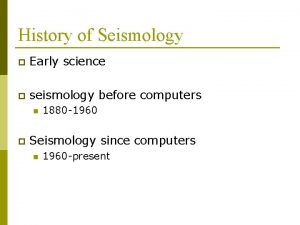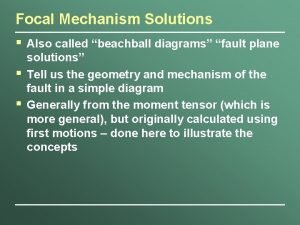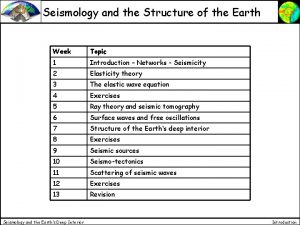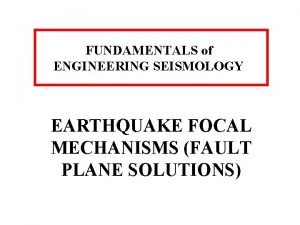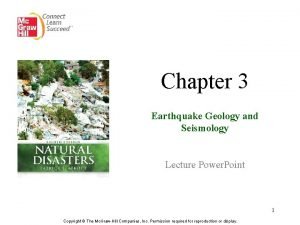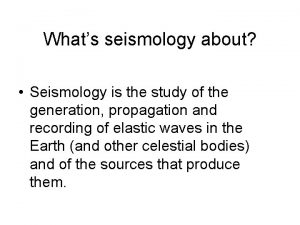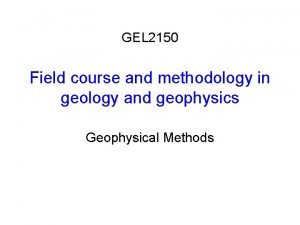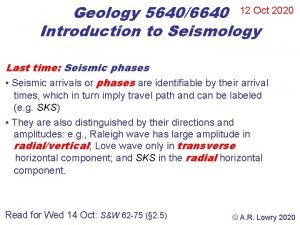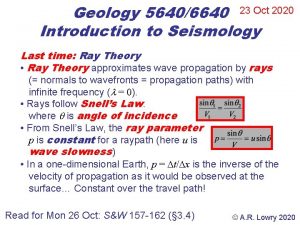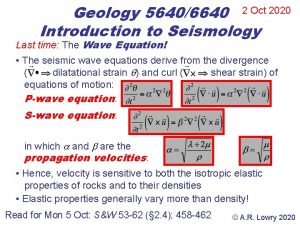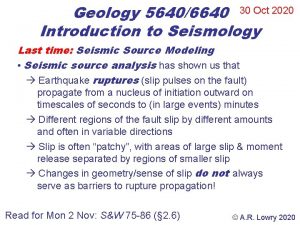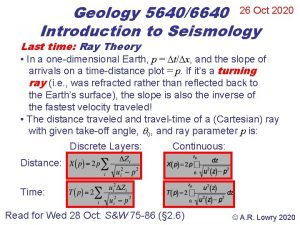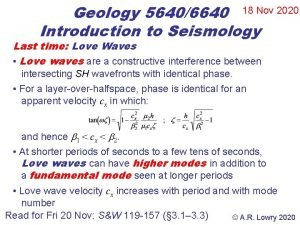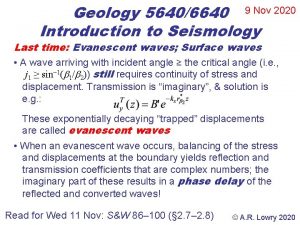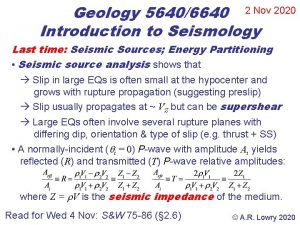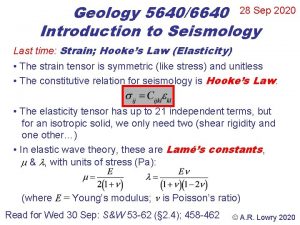Geology 56406640 7 Oct 2020 Introduction to Seismology










- Slides: 10

Geology 5640/6640 7 Oct 2020 Introduction to Seismology Last time: The solution to the Wave Equation! • The wave equations expressed in terms of displacement potentials: can be solved by plugging in eigenfunctions of the form: and solutions are: • Note these are alternative expressions of the more familiar v = f ! Read for Fri 9 Oct: S&W 53 -62 (§ 2. 4); 458 -462 © A. R. Lowry 2020

Geology 5640/6640 Introduction to Seismology Last time continued: Harmonic wave motion • Harmonic wave motion can be described entirely by specifying a period T (= 1/f = 2 / ), wavelength (= 2 /k), and a phase (= t 0 = x 0/c = tan-1[a 1/a 2]) for a function f(t) = a cos( t + ) = a 1 cos( t) + a 2 sin( t) • Using Euler’s identity, a 1 and a 2 can be shown to be equivalent to the real and imaginary parts (respectively) of a complex-valued sinusoidal amplitude!

Homework Assignment 1 is now posted on the course website… Along with other materials you’ll need. Due Monday, 19 October at 8: 30 am

Polarizations of P- and S-waves: The polarization (or “polarity”) of a wave is a way of describing the direction of initial particle motion of a wave (i. e. , the “first motion”). For example, a seismologist might say “The first motion on the North-South component was down. ” This implies a reference frame however… First consider a P-wave (scalar displacement potential) with equation: solution: We could write this as: where the first part ( 1) travels in the +x direction, and the second ( 2) travels in the –x direction (i. e. a “plane wave”). Displacement is related to the potential by the gradient:

Here our y, z components disappeared because there’s no y, z dependence for a plane wave traveling in the x-direction: So, u = (–ik , 0, 0), and particle displacement is always in ± the direction of wave propagation, i. e. , perpendicular to the wave front. If the first motion is compressive, all points on the wavefront move in the direction of the black arrows (“positive” or “upward” polarity); if dilatational, they all move in the direction of the red arrows. This is also called longitudinal displacement…

Now consider the S-wave (vector displacement potential)… Like before we’ll consider a plane wave propagating only in the x-direction: equation: solution has three components: To write this in terms of displacement we take the curl: Since it’s propagating only in the x-direction, the y- and z-derivatives again vanish, leaving:

So for an S-wave propagating in the x-direction, particle motion is only in the y- and z-directions, and not the x-direction. We further decompose the wavefield using a convention that: SH = horizontally polarized shear wave SV = vertically polarized shear wave Both of these are always perpendicular to the propagation direction, with SH in the horizontal plane and SV in the direction orthogonal to both the propagation direction and SH.

Thus for our example of a shear wave propagating only in the x-direction: Different texts illustrate this differently; one way is to think of a series of blocks:

To visualize SH and SV a little better, consider a point source deep within a constant-velocity medium: The ray paths must be straight lines; the wavefronts are spheres.

Now imagine the same source-receiver pair for a medium in which velocity increases with depth: The definition’s the same, but now the angle between direction of propagation & the horizontal is changing (so angle of SV motion WRT horizontal also changes).
